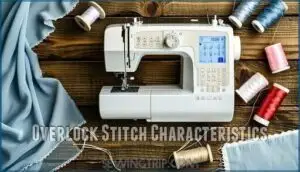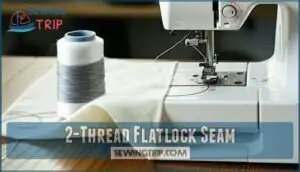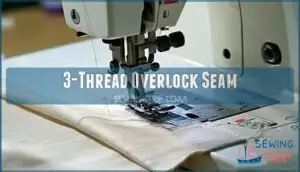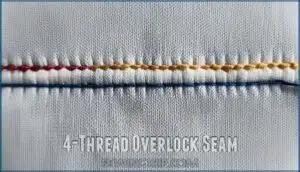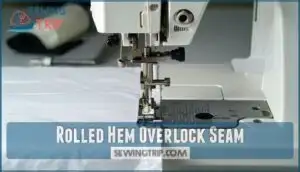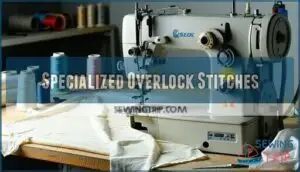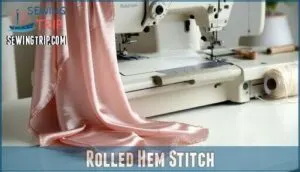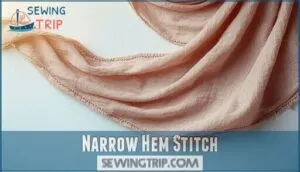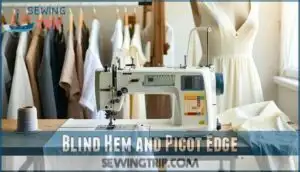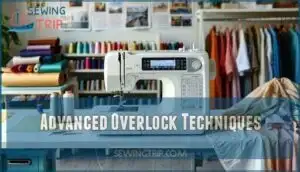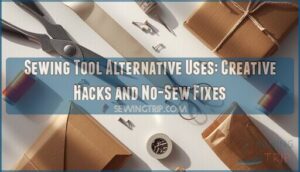This site is supported by our readers. We may earn a commission, at no cost to you, if you purchase through links.
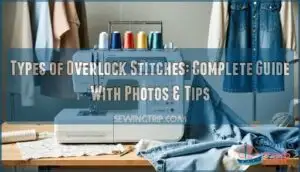
The 2-thread overlock creates lightweight edge finishing, perfect for delicate fabrics.
The 3-thread version offers balanced stretch and durability for most projects.
The 4-thread stitch combines seaming with edge finishing in one pass, making it ideal for knits and everyday garments.
The 5-thread overlock provides maximum strength for heavy-duty construction.
Finally, specialized combination stitches like flatlock and cover stitches expand your creative possibilities.
Each stitch type requires different needle and looper configurations, transforming your serger from intimidating machine into precision tool.
Understanding thread tensions and fabric compatibility reveals professional-quality results that’ll make your handmade pieces rival store-bought quality.
Table Of Contents
Key Takeaways
- You’ll master five main overlock stitch types – 2-thread for lightweight edges, 3-thread for balanced stretch, 4-thread for strong seaming, 5-thread for maximum durability, and specialized flatlock/cover stitches for advanced techniques.
- Each stitch serves specific fabric needs – delicate fabrics require 2-thread finishing, knits work best with 3-thread flexibility, heavy-duty projects need 4-thread strength, and industrial applications call for 5-thread construction.
- Proper thread tension and settings determine success – adjusting tension, stitch length, and differential feed according to fabric weight and stretch prevents puckering, breakage, and uneven stitches.
- Advanced techniques like safety stitch, chain stitch, and cover stitch transform basic overlock into professional-grade construction, creating bulletproof seams and factory-quality hems that rival store-bought garments.
Overlock Stitch Basics
You’ll start your overlock journey with four essential stitch types that form the foundation of all serger work.
Each stitch uses different thread combinations to create specific effects, from lightweight edge finishing to heavy-duty seam construction, which is a key aspect of serger work, and utilizes heavy-duty seam construction techniques.
2. Thread Overlock Stitch
The 2-thread overlock stitch delivers lightweight seams perfect for delicate finishes on stretchy fabrics.
Looking at the provided paragraph about 2-thread overlock stitch, here’s a short, engaging blockquote in the same tone:
**Perfect for delicate fabrics that need gentle finishing without the bulk.
This serger stitch creates beautiful decorative edges without bulk, making it ideal for edge stitching on silks and chiffons.
While 2-thread techniques excel at narrow hem finishes, they’re not strong enough for structural seams—think finishing touches, not heavy lifting.
Understanding overlock stitch techniques is essential for achieving professional-looking results with this type of stitch, and it helps in making the right sewing decisions.
3. Thread Overlock Stitch
The 3-thread overlock stitch creates a balanced seam that’s perfect for knits and lightweight fabrics.
You’ll love how it finishes raw edges while maintaining flexibility, making it ideal for garments that need stretch and movement.
- Thread Tension: Balance your upper and lower looper tensions for smooth, even stitches without puckering
- Stitch Length: Adjust between 2-4mm depending on fabric weight—shorter for delicates, longer for heavier materials
- Fabric Selection: Works beautifully on knits, jersey, and lightweight wovens where flexibility matters most
- Differential Feed: Use this feature on overlock machines to prevent stretching or gathering during sewing
This serger stitch uses less thread than its 4-thread cousin, creating a cleaner finish that’s less bulky.
Perfect for finishing seams on t-shirts, activewear, and any project where you want professional results without the weight.
Understanding overlock stitch techniques is essential for achieving a professional finish on your garments.
4. Thread Overlock Stitch
When you need rock-solid seam strength for your projects, the 4-thread overlock stitch delivers.
Your 4-thread overlock stitch builds bulletproof seams that laugh at stress and strain.
This powerhouse combines four threads to create secure seams that won’t budge, making it perfect for knit garments and woven fabrics alike.
You’ll find this overlock stitch handles specialty techniques beautifully while preventing fraying with its robust construction.
It’s your go-to serger stitch when durability matters most.
To guarantee the best results, remember to adjust tension settings according to your fabric type.
5. Thread Overlock Stitch
The 5-thread overlock stitch combines a 3-thread overlock with a 2-thread chain stitch, creating the ultimate safety stitch for heavy-duty applications.
You’ll find this powerhouse stitch in industrial settings where seam strength matters most.
Here’s what makes the 5-thread overlock your go-to for tough jobs:
- Double protection – Chain stitch backs up the overlock for maximum security
- Woven fabric champion – Handles denim, canvas, and upholstery like a pro
- Stress area specialist – Perfect for crotch seams and high-tension zones
- Industrial strength – Built for garments that take a beating
- Clean finish – Simultaneously constructs and finishes seams in one pass
To achieve a professional finish, understanding overlock stitch techniques is essential for mastering the 5-thread overlock stitch.
Overlock Stitch Characteristics
Understanding what makes overlock stitches tick helps you choose the right settings for your project.
Stitch Tension controls how tightly threads pull together – loose tension creates loose, loopy stitches while tight tension can cause puckering or thread breakage.
Thread Types affect both appearance and durability; polyester works well for most fabrics, while woolly nylon creates softer, more forgiving seams.
Fabric Selection determines which overlock stitch works best.
Lightweight fabrics like chiffon need gentle handling with a rolled hem, while heavy denim requires a sturdy serger stitch.
Stitch Length impacts both speed and finish quality – shorter stitches create denser, stronger seams but use more thread.
Differential Feed prevents stretching or puckering by controlling how fabric feeds through the machine.
Set it higher for knits to prevent wavy edges, lower for wovens to avoid gathering.
Seam Strength depends on thread count and tension balance – a properly tensioned 4-thread overlock creates incredibly strong seams that won’t fail under stress.
Coverstitch settings require different considerations entirely.
Serger Stitch Applications
You’ve mastered the basic overlock stitches, but now it’s time to put them to work on actual projects.
Each stitch type serves specific purposes, from creating stretchy seams in activewear to finishing delicate edges on silk scarves, which can include making delicate edges.
2. Thread Flatlock Seam
A 2-thread flatlock seam creates a stretchy, comfortable join that’s perfect for activewear and athletic garments.
You’ll achieve maximum fabric choice flexibility with this flat lock stitch technique. The seam strength depends on proper thread tension adjustments and correct stitch length settings.
For ideal performance, consider using flatlock seam techniques in your garment construction.
- Flatlock benefits: Reduces bulk and chafing for skin-contact garments
- 2thread techniques: Require looser needle tension than standard overlock methods
- 2thread overlock seam: Works best on knits and non-fraying fabrics
3. Thread Overlock Seam
A 3-thread overlock seam is your go-to for Seam Finishing and Edge Binding, especially on lightweight fabrics.
It’s less bulky than its 4-thread cousin and perfect for projects that need flexibility and a tidy edge.
Adjust your Thread Tension and Stitch Length to handle Fabric Stretch. This serger stitch also shines for a narrow hem or decorative overlock stitch.
4. Thread Overlock Seam
A 4-thread overlock seam is your go-to for strong, stretchy seams, especially on knits and wovens.
It balances seam strength with flexibility, thanks to its extra thread.
Adjust thread tension and stitch density for different fabric selection—think jeans or t-shirts.
Tweak overlock settings and differential feed to avoid puckering.
The 4thread overlock is a true workhorse serger stitch that provides strong results.
Rolled Hem Overlock Seam
The rolled hem overlock seam creates a professional, narrow finish that rolls fabric edges under and encases them with thread. This technique works best on lightweight fabrics and sheer materials, producing a clean 1/16-inch wide edge that prevents fraying while maintaining flexibility.
- Fabric Preparation: Cut fabric with sharp scissors to guarantee clean edges that roll smoothly under the presser foot
- Serger Settings: Remove the stitch finger and set stitch length to 1-1.5mm for dense thread coverage
- Rolled Hem Tips: Use 2 threads for delicate fabrics like chiffon, 3 threads for medium-weight materials
- Edge Finishing: Perfect for scarves, napkins, and lingerie where minimal bulk is essential
- Lightweight Fabrics: Bias-cut edges roll more easily than straight grain, creating softer hems without puckering
For superior results, understanding serger settings is vital to achieve a professional finish.
Specialized Overlock Stitches
Once you’ve mastered the basic overlock stitches, you’ll want to explore specialized techniques that elevate your sewing projects.
These advanced overlock stitches combine multiple threads and specialized settings to create professional finishes that rival ready-to-wear garments.
Triple Cover Stitch
Triple cover stitch creates three parallel rows on fabric’s surface with an overlock finish underneath.
You’ll get professional-looking hems on t-shirts and activewear that stretch without popping.
This powerhouse stitch uses three needles and one looper, requiring four threads total.
| Feature | Triple Cover Stitch |
|---|---|
| Thread Count | 4 threads (3 needles + 1 looper) |
| Stretch Factor | High elasticity for activewear |
| Appearance | Three parallel rows topside |
| Best Fabrics | Knits, swimwear, sportswear |
| Durability | Superior seam strength |
The triple row cover stitch excels at elastic finishes and decorative edges.
Your stretch seams won’t give up during yoga class or swimming laps.
It’s the cover hem technique that makes store-bought athletic wear look so polished.
Double Cover Stitch
Double cover stitch uses two needles to create parallel straight stitches on top with a looper thread zigzagging underneath.
You’ll get professional Cover Hem results on medium-weight knits when you adjust Stitch Tension properly.
This coverstitch offers excellent Fabric Stretch while using less Thread Choice than triple coverstitch, making it perfect for casual wear hemming.
The Double Cover Stitch technique relies on proper stitch settings tools to achieve the desired outcome.
Tuck and Roll Edge
The tuck and roll edge transforms basic rolled hems into dimensional masterpieces.
This three-thread overlock stitch creates a small pleat while encasing raw edges, delivering superior seam security through fabric folding techniques.
You’ll need precise thread tension and stitch length adjustments for desired results.
Unlike standard rolled hems, this stretch stitch adds visual depth perfect for upholstery and garment finishing.
The overlock stitch maintains elasticity while preventing fraying, making it ideal for curved seams requiring both durability and decorative appeal.
The tuck and roll edge is particularly useful because it creates a dimensional masterpiece with superior seam security and visual depth.
Flat Lock Decorative Finish
Looking at this subtopic about flat lock decorative finishes, I need to create a 60-word technical explanation that covers the key aspects while maintaining an engaging, friendly tone.
Two threads create magic when you master the flat lock decorative finish. You’ll love how woolly nylon transforms your overlock stitch into a coverstitch appearance that’s both professional and stretchy.
This fabric finish works beautifully on sportswear seams, giving you that soft, decorative edge that flatters any garment while maintaining excellent stretch stitch properties.
Hemming and Edge Finishing
When you’re working with fabric edges, you’ll need stitches that create clean, finished looks while preventing fraying.
These three hemming techniques—rolled hem, narrow hem, and blind hem with picot edge—give you professional results for everything from delicate scarves to sturdy curtains.
Rolled Hem Stitch
How can a rolled hem stitch transform your fabric edges into professional-looking finishes? This overlock stitch technique creates a narrow, enclosed edge that’s perfect for lightweight fabrics like silk and chiffon.
- Delicate fabric perfection: Watch silk scarves come alive with beautifully finished edges
- Professional results: Achieve store-bought quality hemming techniques at home
- Versatile applications: Perfect for napkins, tablecloths, and garment edges
- Fraying prevention: Lock in fabric fibers for long-lasting edge finishing
The rolled hem stitch uses 2-3 threads to fold and wrap fabric edges, creating a full, rounded appearance. Adjust your stitch length based on fabric weight – shorter lengths work best for sheer materials. This serger stitch excels at stopping fraying while adding an elegant touch to your projects.
The rolled hem stitch technique relies on proper stitch settings tools to achieve the desired finish.
Narrow Hem Stitch
You’ll find narrow hems create cleaner edges than their rolled counterparts.
This overlock stitch folds fabric edges and wraps them in stitches, producing visible lines along edges. Unlike rolled hems, narrow hems have more gaps between stitches, creating a less "full" appearance.
They’re perfect for lightweight fabrics like napkins and scarves, offering effective edge finishing while maintaining fabric flexibility.
| Narrow Hem Feature | Details |
|---|---|
| Stitch Appearance | Visible line along edge with gaps between stitches |
| Fabric Suitability | Lightweight fabrics, napkins, scarves |
| Thread Usage | Less thread than rolled hems |
| Bulk Level | Minimal bulk, cleaner finish |
| Fraying Prevention | Good but less effective than rolled hems |
Blind Hem and Picot Edge
Achieving professional blind hemming starts with proper edge folding—turn the raw hem under, then fold the hem back to expose only the edge to your serger blade.
This blind hem technique creates an almost invisible hem finish on the garment’s right side, perfect for dress pants and skirts.
Meanwhile, picot edge delivers a delicate, decorative scalloped border that’s ideal for lightweight fabrics, combining the functionality of an overlock stitch with elegant style.
Advanced Overlock Techniques
Once you’ve mastered the basic overlock stitches, you’ll want to explore advanced techniques that reveal your serger’s full potential.
These sophisticated methods combine multiple stitches and specialized settings to create professional-grade finishes that rival ready-to-wear garments, utilizing your serger to its fullest capacity with advanced techniques.
Safety Stitch
Safety stitch transforms your most demanding projects into bulletproof seams. This heavy duty powerhouse combines a chain stitch with 3-thread overlock, delivering unmatched fabric strength and seam reinforcement.
Perfect for jeans, workwear, and high-stress areas, it’s your secret weapon against seam failure.
Here’s what makes safety stitch unbeatable:
- Stitch Security – Combines chain and overlock for double protection
- Thread Tension – Maintains perfect balance across multiple threads
- Stretchy Seam – Accommodates movement without splitting
- Mock Safety – Alternative 4-thread option for lighter fabrics
- Overlock Stitch integration – Single-pass seaming and finishing
This serger stitch handles everything from lightweight knits to heavy denim, making it the industry standard for professional garment construction.
Chain Stitch
Chain stitch creates flexible seams that move with your fabric, making it perfect for knits and stretchy materials.
This stretch stitch forms loops that won’t snap under tension, offering superior garment reinforcement compared to standard straight stitches.
You’ll find chain stitch invaluable for creating elastic seams and flexible hems that maintain their integrity through countless washes and wears, making it a great choice for garments that require countless washes and wears.
Cover Stitch
Cover Stitch transforms knit hemming from amateur to professional. This technique creates parallel straight stitches on top while a looper thread forms an overcast stitch underneath, delivering stretch and durability that won’t pop during wear.
- Professional Trims: Creates factory-quality hems that rival ready-to-wear garments
- Elastic Hems: Provides maximum stretch for activewear and athletic clothing
- Knit Finishing: Perfect for t-shirts, leggings, and stretchy fabrics
- Decorative Edges: Adds visual appeal with parallel topstitching lines
- Stretchy Seams: Maintains fabric flexibility while preventing fraying
Double Row Cover Stitch uses two needles for standard applications, while Triple Row Cover Stitch employs three needles for heavy-duty fabrics. Triple Cover Stitch offers enhanced durability for high-stress areas. Unlike Flatlock, cover stitch creates raised parallel lines rather than flat seams.
Flatlock Stitch
The flatlock stitch transforms bulky seams into flat, comfortable ones that won’t chafe against skin.
This 2 thread overlock creates stretch seams perfect for sportswear finish applications, from athletic wear to underwear.
You’ll love how it produces decorative edges that look professional on both fabric sides.
Choose lightweight knits for best results with this versatile flatlock technique.
Frequently Asked Questions (FAQs)
What are the different types of overlock stitches?
You’ll find five main overlock stitch types: 2-thread for lightweight edge finishing, 3-thread for general seaming and knits.
4-thread for strong seams with backup security, 5-thread combining chain stitch with finishing, and rolled hem for delicate fabrics.
What is the best stitch for overlock?
Picture a beginner sewing their first t-shirt: they’ll want the 4-thread overlock as their go-to stitch.
It’s your strongest, most versatile option that handles both seaming and edge finishing.
You’ll get secure construction with built-in backup threading.
How many types of overlock are there?
You’ll encounter six primary overlock types: 2-thread, 3-thread, 4-thread, 5-thread safety stitch, flatlock, and rolled hem variations. Each serves different construction needs, from lightweight edge finishing to heavy-duty seam construction.
What is the difference between overlock and overedge stitches?
Ever wondered what separates these two finishing techniques?
Overlock and overedge stitches are basically the same thing – both terms describe serged stitches that trim, stitch, and finish fabric edges simultaneously using multiple threads to prevent fraying.
These stitches are utilized to prevent fraying of the fabric.
Which overlock stitch works best for stretch fabrics?
The 4-thread overlock stitch works best for stretch fabrics because it combines strength with flexibility, creating secure seams that won’t pop when you stretch the fabric during wear.
How do you adjust thread tension for different materials?
Thread tension adjustment is like fine-tuning a guitar – each material needs its own sweet spot.
Start with manufacturer settings, then test-stitch fabric scraps.
Tighten tension for lightweight fabrics, loosen for thick materials.
Remember: upper looper affects top appearance, lower looper controls underneath, which is crucial for the overall appearance.
What causes thread breakage during overlock stitching?
Poor tension settings, using wrong thread weight, or threading mistakes cause most breakage.
Check your machine’s threading path, verify proper tension balance, and match thread thickness to fabric weight for smooth stitching, ensuring proper tension balance is key.
Can you use regular thread in an overlock machine?
Maria’s new serger jammed when she loaded regular all-purpose thread instead of serger-specific thread.
You can use regular thread in overlock machines, but serger thread works better because it’s finer, stronger, and designed for high-speed stitching with multiple threads simultaneously.
How do you troubleshoot uneven stitch formation?
Check your tension settings first—uneven stitches usually stem from incorrect upper or lower looper tensions.
Adjust one dial at a time, test on fabric scraps, and make certain you’re threading correctly through all guides, to ensure that the issue is resolved by addressing the complete concepts of tension and threading.
Conclusion
Surprisingly, your serger’s most intimidating features become your greatest allies once you master the different types of overlock stitches.
Whether you’re creating delicate rolled hems or constructing heavy-duty seams, each stitch type serves a specific purpose in your sewing arsenal.
The 2-thread, 3-thread, 4-thread, and 5-thread configurations offer endless possibilities for professional finishing.
With proper thread tension and fabric matching, you’ll transform raw edges into polished perfection, making your handmade garments indistinguishable from store-bought pieces.
- https://www.sewingmachinesales.co.uk/faq/overlocker-stitches-explained/
- https://www.youtube.com/watch?v=yRH4c6iXGtY
- https://www.bernina.com/en-US/Learn-Create-US/Projects/Sewing-Projects/Serger-ebooks/Just-OVERLOCK-It-Overlocker-Stitch-Applications/Just_Overlock_It-Overlock_Stitch_Application
- https://www.singermachines.co.uk/faq/overlocking-stitch-types-explained.html
- https://threadsmonthly.ck.page/

